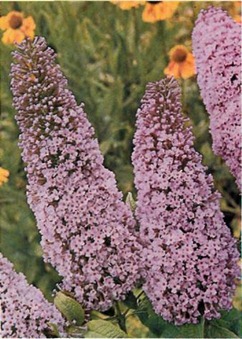





The late-summer-flowering shrubs to prune towards the end of early spring include the following:
Prune only to tidy, cut out weak and straggling growth and one or two of the oldest shoots; regular annual pruning not necessary.
Prune only those with coloured leaves, eg., Rose Glow, Aurea, and purple-leaved kinds except the dwarf form, since the young leaves and stems have the best colouring. Cut the main stems to strong new side-shoots and occasionally cut out one or two of the oldest shoots completely.
 Buddleia davidii and varieties (butterfly bush)
Buddleia davidii and varieties (butterfly bush)
Cut last year’s long shoots back hard to leave a length of stem with only three or four dormant buds on it. In cold districts wait until mid-spring.
This is mostly spur-pruned: the new shoots are cut back to stumps with two buds on them, once the main shoots have filled the space available, but a few new shoots are left at their full length in suitable positions to clothe the support and the plant.
Cut flowered shoots moderately hard to leave about 23cm (9m) of stem, and cut weak shoots back hard, to leave a stub with one or two buds. In cold districts wait until mid-spring before you do this pruning.
Ceratostigma willmottianum (plumbago)
Cut back hard almost to ground level; in cold seasons or districts leave until mid-spring.
In mild districts cut off dead shoots and parts of shoots now and cut live side-shoots back to one or two pairs of buds. In other districts and cold seasons leave this until mid-spring.
Trim with shears to cut off the flowered shoots.
Cut off old flower-heads to just above a pair of good buds; cut back some of the oldest shoots to ground level and those shoots killed by cold. Thin new shoots coming from ground level, otherwise they will be crowded.
Hardly any pruning; remove weak shoots.
Cut back the tall kinds hard so that last season’s new shoots are reduced to a quarter of the length. Be careful with H. x moseranum; remove dead shoots only when new ones start to sprout.
Annual pruning is not essential but better flowering will be obtained by cutting last season’s new side-shoots back to leave stubs to produce new stems. Dead tips should be cut off and weak shoots removed to avoid overcrowding.
Remove some of the oldest stems at ground level and cut back last season’s flowered growth by about half. In cold districts and seasons wait until mid-spring.
Cut out the oldest stems and weak shoots completely and cut the strongest growth from last season by a half to two-thirds.
Cut to ground level to produce small, bushy and very floriferous plants or prune in mid-autumn.
Cut last season’s new shoots back to leave stubs 5 or 7.5cm (2 or 3in) long, so that plenty of new foliage is produced.
Every year, before new growth begins to appear, the weakest shoots should be cut back hard to leave one or two buds, and some of last year’s strongest shoots pruned to leave three or four buds. Choice of shoot for cutting should ensure that the space allowed for growth is covered adequately and evenly.
Prune very hard, almost to ground level, leaving stubs with strong buds on them.
Prune last year’s new growth to leave only 1.2cm (1/2in) stubs of it. Do not cut into growth older than this.
Cut last season’s shoots back very hard to within a few centimetres (inches) of ground level; in some years cut out completely one or two of the oldest shoots also.
Cut out the weakest, oldest and straggling snoots completely and thin the remainder, making all cuts to ground level.
Cut last season’s new growth back to leave stubs with dormant buds on them.
Copyright © www.100flowers.win Botanic Garden All Rights Reserved